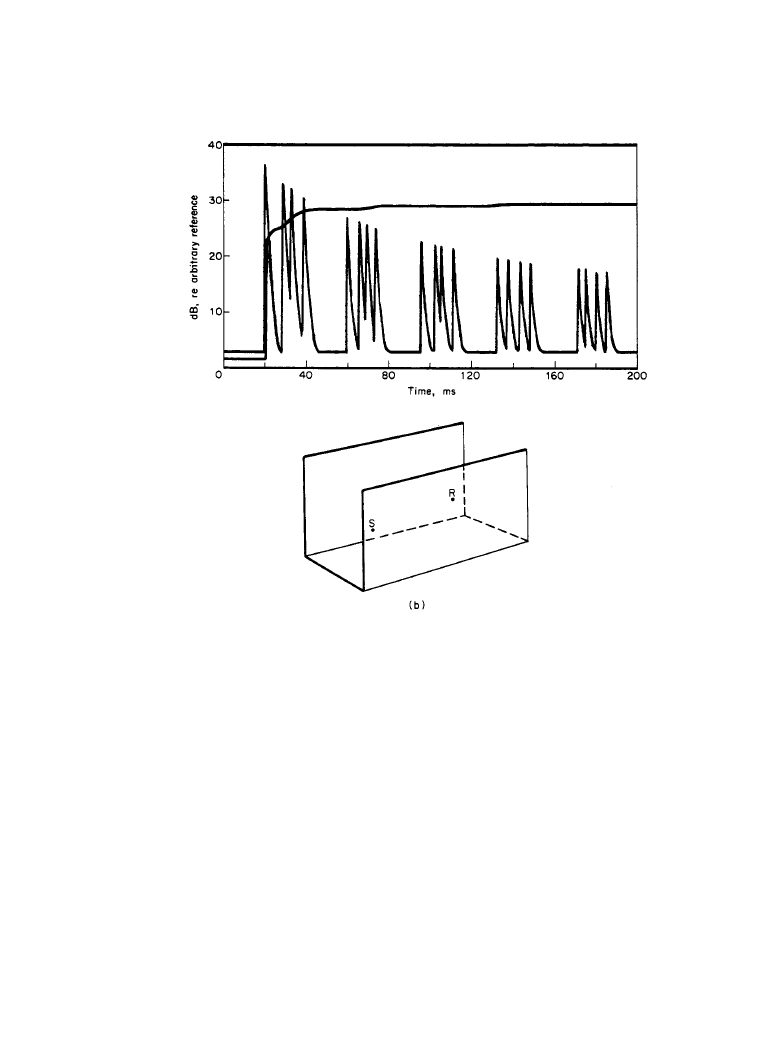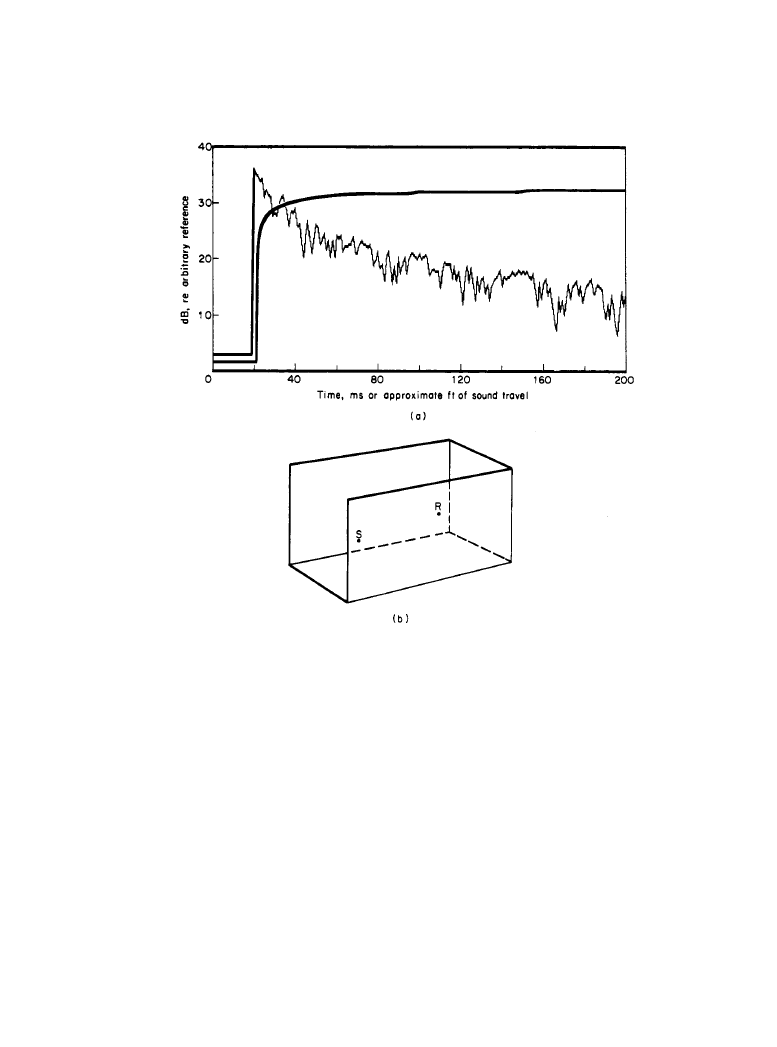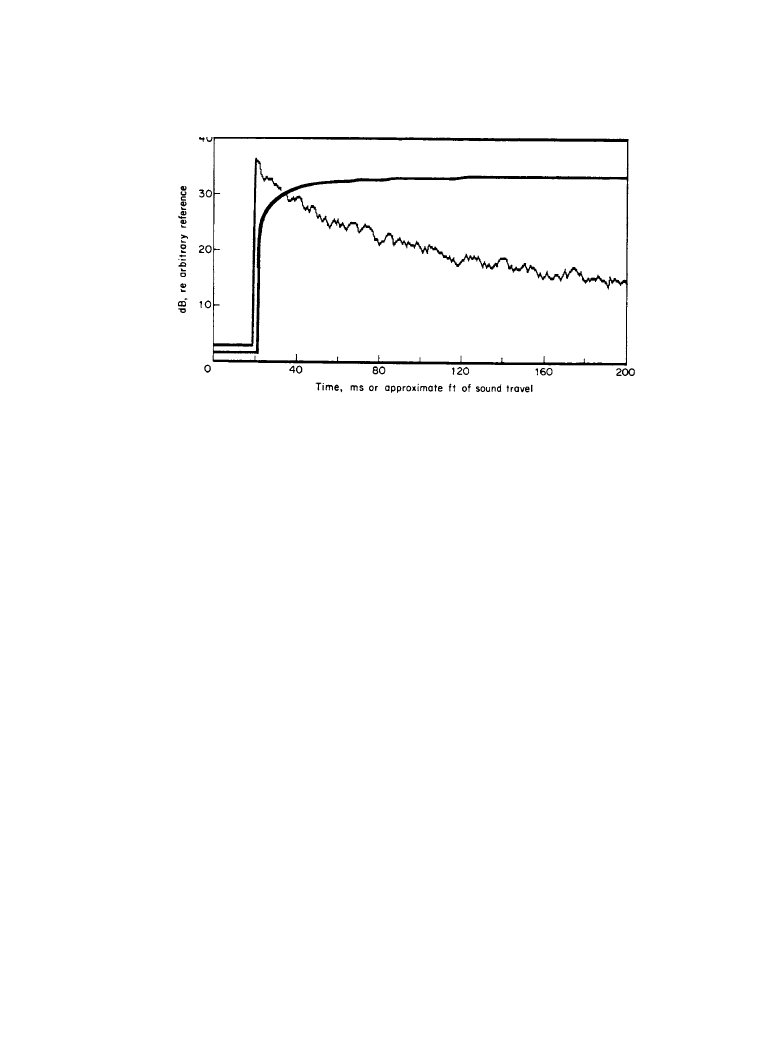ВУЗ: Казахская Национальная Академия Искусств им. Т. Жургенова
Категория: Книга
Дисциплина: Не указана
Добавлен: 03.02.2019
Просмотров: 21625
Скачиваний: 19

Sound Isolation 3-45
3.3.4a
Design Concerns of Spaces
It is rare that an auditorium is used for a single purpose; optimum acoustical requirements vary
widely for each type of usage. For example, reverberation time may require changing over a
range of 1 to 2 s. Some hall designs have used revealable acoustical absorption to attempt this
change; solid wall panels open up so that fabric panels can be extended. This may be an
unwieldy solution, for not only does it require large dedicated wall spaces, but it may also kill
desirable lateral reflections that enhance the early-arriving sound.
Alternatively, significant gains can be made through the application of directional loudspeak-
ers for those activities that require a shorter reverberation time, such as speech. By aiming the
majority of the sound energy at the audience, the proportion of the energy in the early-arriving
sound is substantially increased compared with the sound energy entering the reverberant field,
thus increasing intelligibility. Be warned that directional speakers cannot be used to full effec-
tiveness in spaces where the basic sound absorption has not been applied.
Figure 3.3.7
Echogram of flutter between parallel walls.
Downloaded from Digital Engineering Library @ McGraw-Hill (www.digitalengineeringlibrary.com)
Copyright © 2004 The McGraw-Hill Companies. All rights reserved.
Any use is subject to the Terms of Use as given at the website.
Sound Isolation

3-46 Architectural Acoustic Principles and Design Techniques
Another choice is to build a short reverberation time into the basic acoustics of the space;
then as each application warrants, the reverberant field is reinforced with a sound system that
amplifies the reverberant-sound field. One advantage of these electronic methods is that sound
can be readily equalized for each application over the full frequency range; in contrast, this is
almost impossible with mechanical devices. These electronic techniques may be applied strategi-
cally only to selected areas of a hall, such as areas deep under balcony seating, where local rever-
beration is restricted.
Small Rooms
When the dimensions of a space become comparable with the wavelength of the sound, simple
acoustic methods are inappropriate because it no longer is possible to access the properties of the
whole space by using the available properties of component parts. More confidence can be
placed in the design of acoustic properties of an interior space when the space has dimensions
Figure 3.3.8
Echogram of partial reverberation in an incomplete room.
Downloaded from Digital Engineering Library @ McGraw-Hill (www.digitalengineeringlibrary.com)
Copyright © 2004 The McGraw-Hill Companies. All rights reserved.
Any use is subject to the Terms of Use as given at the website.
Sound Isolation

Sound Isolation 3-47
much larger than the wavelength of the sound, where, for example, flat surfaces reflect sound
with the angle of incidence equal to the angle of reflection. Sound energy pumped into a small
space may influence the production of the immediately following sound. Thus, as the room
becomes smaller, it becomes less possible to predict the outcome accurately. Surfaces are
smaller, and the popular sound-ray diagram is entirely inappropriate, especially for low frequen-
cies. Also, the smaller-angled surfaces can become stiffer and the construction becomes less uni-
form, making any mathematical description of the environment very difficult.
For these reasons, no specific recommendations can be made, for each component is an inte-
gral part of a close-coupled system in which each component reacts with all others. However,
two useful observations may be made:
•
If an acoustically symmetrical room is required at low frequencies, it should have symmetri-
cal construction well beyond the interior walls. A room with a gypsum wall tied to a cinder-
block wall on one side is not the same as a freestanding wall on the other. They may appear to
be the same, but they are not the same acoustically.
•
A variety of construction techniques, each of a different surface weight and stiffness, can
improve the uniformity of the response of the room throughout its frequency range.
When the acoustics of a space needs correction, many complex techniques are available to
track down the problem. Besides microphone systems, accelerometers can be used to analyze
wall vibration levels in conjunction with the sound pressure level.
3.3.4b
Masking
Masking is used in spaces in which sound sources need concealing. For example, in an open
administrative office where the conversations of others are readily overheard, the noise criterion
may be less than 35. But rather than applying noise controlling devices and destroying the func-
Figure 3.3.9
Echogram of reverberation in a complete room.
Downloaded from Digital Engineering Library @ McGraw-Hill (www.digitalengineeringlibrary.com)
Copyright © 2004 The McGraw-Hill Companies. All rights reserved.
Any use is subject to the Terms of Use as given at the website.
Sound Isolation

3-48 Architectural Acoustic Principles and Design Techniques
tionality of the space, the interior noise level may be raised to mask the conversations. This is
achieved by installing an array of small loudspeakers inside the drop ceiling that uniformly dis-
tribute broadband noise throughout the plenum to the space below. Provision is made within the
master broadband noise generator for adjustment of the spectral shape so that maximum speech
masking can be obtained with a minimum amount of obvious sound intrusion. Even so, it is pref-
erable to introduce such systems to the office environment slowly by increasing the sound level
gradually over a period of weeks until the goal is reached. These units may also be installed
above corridors to prohibit eavesdropping on conversations in adjacent rooms. In sleeping areas
masking will blot out intrusive sounds.
There is a limit to the application of masking systems. The masking noise levels cannot
exceed NC 40 without being regarded as a noise intrusion.
3.3.5
Annoyance
Annoyance is very difficult to quantify. But often when sound becomes noise, pleasure becomes
annoyance. Each person has his or her own way of reacting to the wide variety of sounds. Here
are some factors that influence the degree to which people are annoyed.
•
Source of sound: An individual will react differently to the same noise coming from different
sources. The noise of a neighbor cutting a lawn is annoying. On the other hand, the noise from
cutting one's own lawn is acceptable, while the noise of a neighbor cutting your lawn is music.
•
Benefit of sound: If the sound is the result of an activity that brings economic benefit to the
listener, tolerance increases. A town official supports renting the local stadium to a rock
group because it will provide significant income, but residents fear outsiders' causing damage
and congestion.
•
Adaptation: People become used to certain noises. A freight train passes each night 50 ft from
a sleeping family. It passes undetected. For the same family, a night in the country is disturb-
ingly quiet.
•
Impulsive noise: Impulsive noise is more annoying than steady noise, particularly if it occurs
at unpredictable intervals. The slamming of automobile doors as people arrive and depart
often causes complaints.
•
Tonal noise: If the sound contains a tonal component such as a whine, buzz, or hum, it is
more annoying than broadband noise of the same loudness. Many state and local governments
recognize this by lowering the permissible noise limits for such sounds. A rooftop transformer
and an exhaust air blower are typical offenders.
•
Variability: Sounds which vary more in amplitude with time are more annoying than steady
sounds. The greater the statistical standard deviation of the sound, the more annoying it is.
•
Speech interference: Typical speech has a level of 60 dBA at the listener’s ear. Other sounds
may mask speech so that it becomes unintelligible. For example, the noise of a nearby heat
pump may make speech unintelligible on the neighbors' patio. Special procedures to deter-
mine the intelligibility of speech may be found in [5].
In some instances, however, evaluation of a noise complaint in terms of the listed items may
show minimal impact. But careful investigation may further show that other important issues
Downloaded from Digital Engineering Library @ McGraw-Hill (www.digitalengineeringlibrary.com)
Copyright © 2004 The McGraw-Hill Companies. All rights reserved.
Any use is subject to the Terms of Use as given at the website.
Sound Isolation

Sound Isolation 3-49
hide behind protests. For example, residents who live near an outdoor amphitheater may be more
concerned about property damage, trespassing, and parking-lot activities than about noise. It is
therefore important to consider all aspects of the operation of a facility.
3.3.6
References
1.
ANSI: American National Standard.for Rating Noise with Respect to Speech Interference,
ANSI S3.14-1977, American National Standards Institute, New York, N.Y., 1977.
2.
ASHRAE: ASHRAE Handbook—1984 Systems, American Society of Heating, Refrigerat-
ing and Air-Conditioning Engineers, Atlanta, Ga., 1984.7.Marshall, Harold, and M. Bar-
ron: “SpatiaI Impression Due to Early Lateral Reflections in Concert Halls: The Derivation
of the Physical Measure,” JSV, vol.77, no. 2, pp. 211-232, 1981.
3.
Siebein, Gary W.: Prolect Design Phase Analysis Techniques for Predicting the Acoustical
Qualities of Buildings, research report to the National Science Foundation, grant
CEE8307948, Florida Architecture and Building Research Center, Gainesville, Fla., 1986.
4.
ANSI: Method for the Measurement of Monosyllabic Word Intelligibility, ANSI S3.2-1960,
rev. 1977, American National Standards Institute, New York, N.Y., 1976.
3.3.7
Bibliography
Beranek, L. L.: Acoustics, McGraw-Hill, New York, N.Y., 1954.
Egan, M. D.: Concepts in Architectural Acoustics, McGraw-Hill, New York, N.Y., 1972.
Huntington, W. C., R. A. Mickadeit, and W. Cavanaugh: Building Construction Materials, 5th
ed., Wiley, New York, N.Y., 1981.
Jones, Robert S.: Noise and Vibration Control in Buildings, McGraw-Hill, New York, N.Y.,
1980.
Kryter, K. D.: The Effects of Noise on Man, Academic, New York, N.Y., 1985.
Lyon R. H., and R. G. Cann: Acoustical Scale Modeling, Grozier Technical Systems, Inc.,
Brookline, Mass.
Marris, Cyril M.: Handbook of Noise Control, 2nd ed., McGraw-Hill, New York, N.Y., 1979.
Morse, P. M.: Vibration and Sound, American Institute of Physics, New York, N.Y., 1981.
Talaske, Richard H., Ewart A. Wetherill, and William J. Cavanaugh (eds.): Halls for Music Per-
formance Two Decades of Experience, 1962-1982, American Institute of Physics for the
Acoustical Society of America, New York, N.Y., 1982.
Downloaded from Digital Engineering Library @ McGraw-Hill (www.digitalengineeringlibrary.com)
Copyright © 2004 The McGraw-Hill Companies. All rights reserved.
Any use is subject to the Terms of Use as given at the website.
Sound Isolation